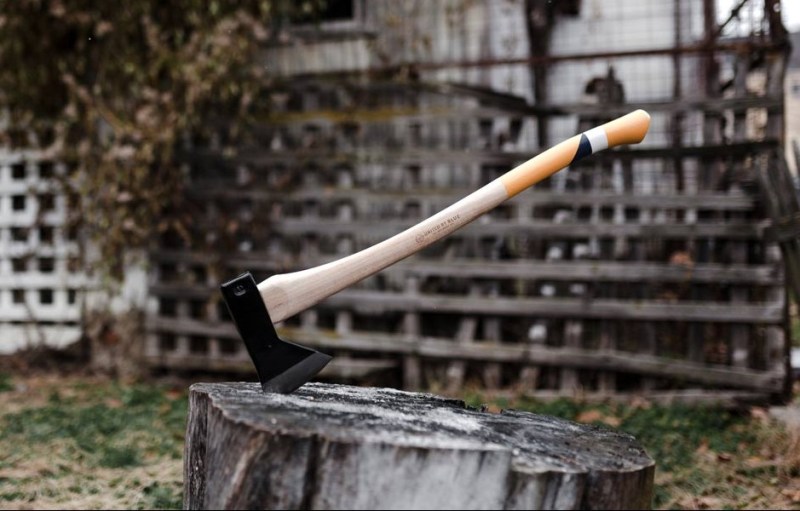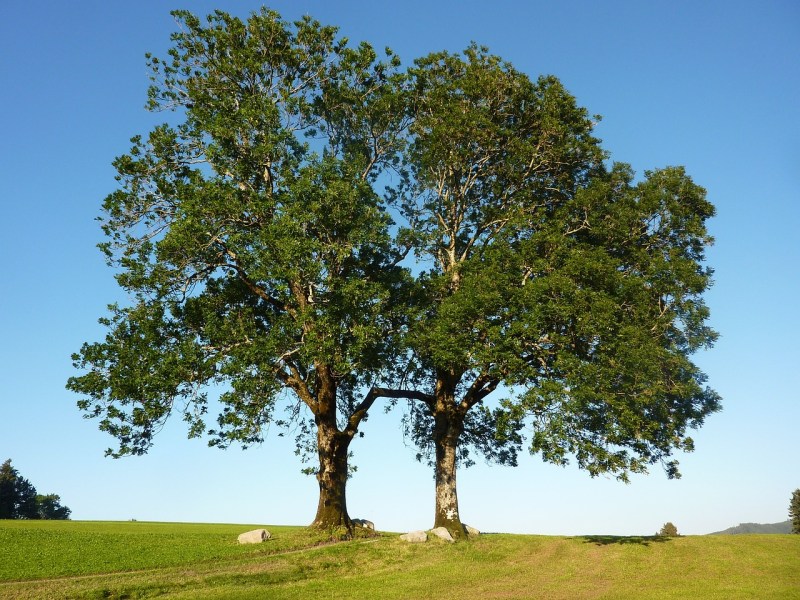It used to be that every good frontiersman had a solid felling axe and a set of woodworking tools. Give a 19th-century ranch hand a summer and he could build you a decent cabin. How many of us today could walk into the woods, pick a tree, and chop it down?
If you’re itching to play the part of a lumberjack beyond the flannel and raw denim pants, you’re in the right place. After spending an early Rocky Mountain spring chopping down a few problem trees in our yard and horse pasture, we’ve learned how to fell a tree with an axe like an expert backwoodsman. Keep reading and we’ll tell you how.
First: Get the right gear

To get started, you’re going to need three basic pieces of gear: an axe, safety glasses, and protective gloves.
The key tool is your axe. We choose for everything from a little car camping hatchet to heavier tools. The Kisa felling axe is a compact felling axe and will make quick work of any tree trunk. Once you’ve got your trunk cut to size, the Bjork splitting axe is an efficient tool that will impress even the most discerning gear junkie.
A good pair of safety glasses is a must-have. These from Klein Tools are affordable and come with either a gray or a clear lens. We also suggest grabbing some gloves. You can go bare-handed, but this pair from is a reliable and affordable option for all kinds of work.
Select your tree

The most important step is picking a tree. Whether you’re looking for firewood during a camping trip (make sure you have a permit to cut wood on state or federal property) or clearing some problem trees from your land, you should look for two things: a safe direction for the tree to fall and a good avenue for you to escape (just in case).
Once you’ve found your tree, check to see if it naturally leans a little to one side. Prevailing winds may have made your job easier if it is already primed to fall in one direction. Next, scope out surrounding trees to make sure the tree won’t snag branches on the way down. Finally, before you start chopping, plan your escape route. When a few hundred- or thousand-pound trunk comes down, you want to be well away from the action.
Cut your notches

Chopping down a tree comes down to geometry and physics. You want to ensure notches create a pivot point so the tree falls in the direction you want it to. Your first axe swings should create a notch in the tree in the direction you want it to fall. Aim between knee and waist high, and penetrate about one-third of the way through the trunk. Ideally, you’ll end up with a triangular cut-out with a flat bottom and a 45-degree slope up and out from the center of the trunk. Alternate between straight chops for the lower portion of the triangle (these should be perpendicular to the ground) with a diagonal downswing up higher.
After you’ve set up your first cut, switch sides. You want your next notch to be about a foot above your first and on the tree’s opposite side. This will create a balanced pivot for the tree to fall on, ensuring it ends up falling in the direction you want it to rather than rolling to one side or the other. Like with the first cut, cut a notch with alternating flat and downswings. Once you are about one-third of the way through the tree, stop.
Bring the tree down

Now comes the dangerous part. Move back to your original notch and start to deepen it. Go slower here because each chop makes that tree a little more unstable. Stick to the same pattern as before, switching between flat swings at the bottom of your notch with steeper downswings from the top.
Listen for cracking and watch for swaying or leaning. Some trees will give you a good warning, while others will fall quietly — and very fast. Be ready to step out of the way quickly and keep moving away from the fall line. If you’ve done your job well, you should be 15 to 20 feet away when the trunk hits the ground and ready to start trimming it down to split into firewood.
What not to do when felling a tree

Now that we’ve covered the basics of axe felling, we want to give you some more safety tips to keep in mind whether you are using an axe or a chainsaw to fell a tree.
First things first, you should never fell a tree any larger than a small sapling by yourself. You might think you’re a great lumberjack and can do it on your own, but it’s better to have someone helping you out and watching your back if the tree starts to fall in an unexpected direction.
If you’re not experienced with a chainsaw, don’t use one. Find someone who has chainsaw experience and ask for help. A chainsaw is a powerful tool, and if you aren’t experienced in the proper way of using one, you could get seriously injured.
This next one probably should go without saying, but the internet is full of people doing dumb things. Don’t stand underneath the tree when someone else is working to cut it down. Stand at a safe distance and keep an eye on the tree, if it starts to fall toward a house or some other structure, don’t try to catch it or block it with your body.



